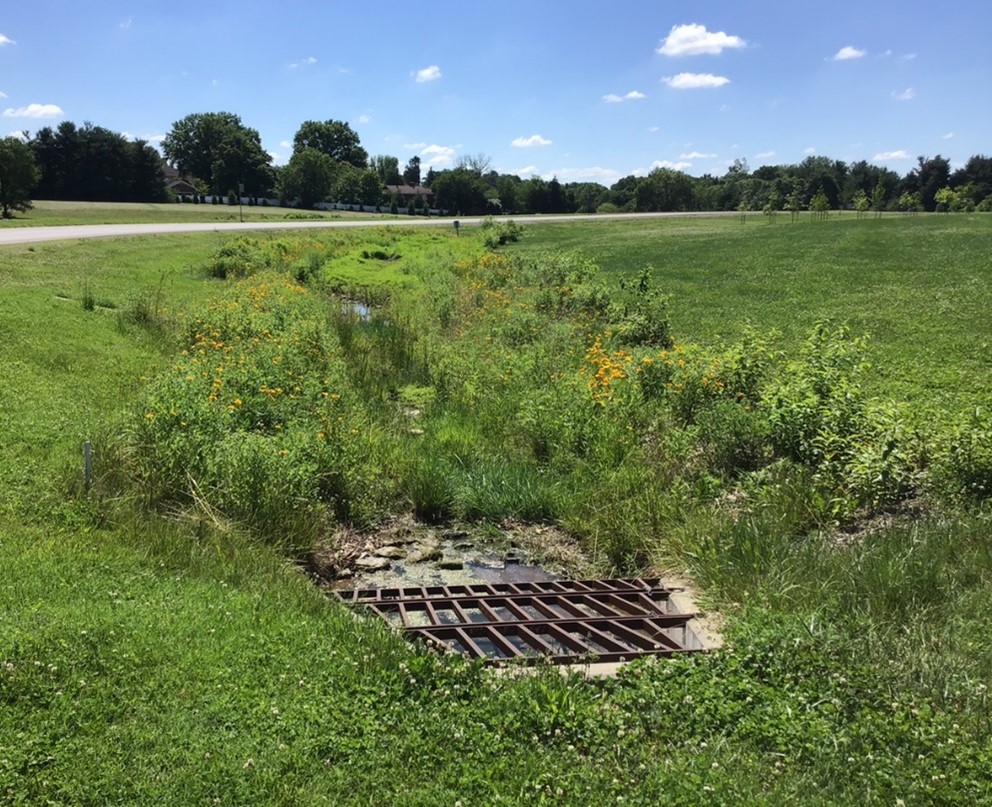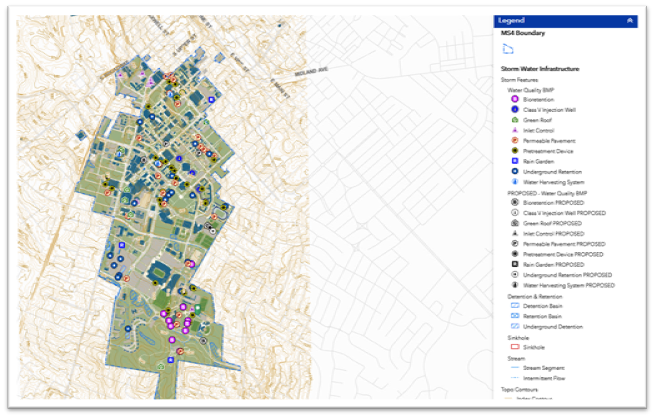Post-Construction BMPs
Requirements
 Post-Construction BMPs are structural and non-structural Best Management Practices put in place after construction occurs in order to obtain permanent stormwater management over the life of a property’s use. These BMPs can be designed to improve water quality and/or water quantity. The University’s MS4 permit requires that the University operate a Post-Construction Stormwater Management Program. As part of this program, LFUCG Post-Construction requirements for New and Re-development have been adopted. University staff oversee the review and approval of construction project stormwater submittals, including proposed structural controls specified to meet water quantity and quality requirements. Detailed information on these requirements and stormwater controls can be found in the Construction section.
Post-Construction BMPs are structural and non-structural Best Management Practices put in place after construction occurs in order to obtain permanent stormwater management over the life of a property’s use. These BMPs can be designed to improve water quality and/or water quantity. The University’s MS4 permit requires that the University operate a Post-Construction Stormwater Management Program. As part of this program, LFUCG Post-Construction requirements for New and Re-development have been adopted. University staff oversee the review and approval of construction project stormwater submittals, including proposed structural controls specified to meet water quantity and quality requirements. Detailed information on these requirements and stormwater controls can be found in the Construction section.
Program
The University’s Post-Construction Stormwater Quality program includes the following components:
- Contract requirements that designers incorporate post-construction stormwater quantity and quality treatment into their design plans for all projects based upon LFUCG requirements.
- Plan review and approval by trained University staff.
- Inspection of BMP installation upon construction completion.
- A perpetual maintenance program that ensures structural controls are being maintained and functioning as designed.
As part of the maintenance program, BMPs receive inspections a minimum of once per 5-year permit cycle. All Underground BMPs are inspected annually, while twenty percent of Above Ground BMPs receive annual inspections. University Grounds is responsible for maintaining all above ground BMPs while University Utilities and Energy Management is responsible for underground BMP maintenance.
As a result of a rapid period of infrastructure growth on campus over the last several years and the vast number of new post-construction BMPs being installed, the need to maintain these devices has become a priority. In response to these needs a Comprehensive Stormwater Operations Manual is being developed that will be an all-inclusive SOP housing all policies, procedures, and BMPs utilized by the University to meet permit requirements. Along with this manual, a preventative maintenance program will be put in place for all structural BMPs. The current Post-Construction BMP Operation and Maintenance Manual has been updated to include this program.
Campus BMPs
Undergoing a significant redevelopment in recent years, the University has seen the number of Post-Construction BMPs grow considerably. At present there are over 150 active BMPs. This number will increase as projects continue across campus. The types of systems utilized on campus include:
|
Types of Campus Structural Post-Construction BMPs |
|
|---|---|
|
Type |
Total |
|
Detention Pond |
25 |
|
Rain Garden |
5 |
|
Permeable Pavement |
23 |
|
Filter Strips/Bioretention |
5 |
|
Vegetated Swales |
7 |
|
Pretreatment Devices |
39 |
|
Green Roof |
6 |
|
Inlet Control |
11 |
|
Sinkhole |
4 |
|
Water Harvesting System |
3 |
|
Underground Detention |
22 |
Mapping
 Information regarding each BMP can be viewed on our Interactive MS4 Map. Here you will find the location of each BMP along with additional information such as:
Information regarding each BMP can be viewed on our Interactive MS4 Map. Here you will find the location of each BMP along with additional information such as:
- BMP Name
- BMP Type/Description
- Photos of the BMP and/or surrounding area
- Watershed boundaries
- Inspection Information
- Topography
- Associated storm sewer lines
*Phase I of this resource was completed in 2021. Phase II has begun and will involve the addition of database functionality. Additional information will be added for each BMP and will include items such as inspection reports, design plans, operation and maintenance information, etc. This additional information will be accessible to all those responsible for the operation and maintenance of the MS4.
